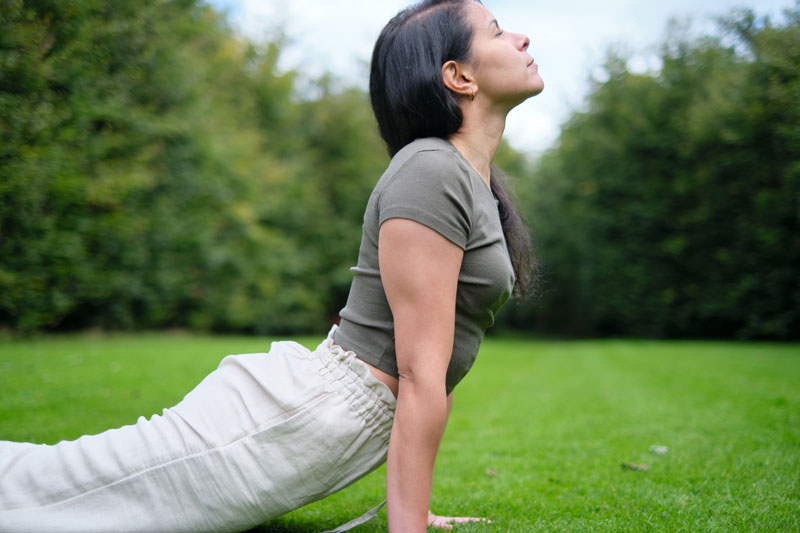
Do you know what is Classical Yoga?
Roseane is a yoga instructor who runs ‘Mai Ram Ireland‘, a classical yoga method.
Today we’ve asked her to share some of her yoga experiences. Keep reading to find out what classical yoga is, its benefits, and more.
What are the benefits of yoga practice?
The benefits of yoga practice depend on the quality of the practice and the frequency one practices. However, more does not always mean better. It is not about more, but about consistency. When I say quality, I do not mean deeper asana, I mean how genuine the practice is. If the class offered is a sport like a student will have the same benefits of practicing most sports with the plus that asanas (yoga postures) stimulate muscles that the average active person is not used to engaging. Then, those muscles will develop, making the student stronger. On sport-like yoga, flexibility and body awareness may also be improved.
The benefits of classical yoga practice are: it can help with regulating bodyweight considering the practitioner is under or overweight; help with coping with anxiety and depression; train focusing and so, improves the quality of concentration; support self-awareness physical and mental; helps to cope with chronic pain; helps to regulate hormonal imbalance; posture recovery; improves mobility; develops clarity. The above are some of the benefits that can be developed over practice and consistency.
What is the difference between classical yoga and other yoga practices?
From what I have been seeing, I am under the impression that there are three forms of yoga in the Media. One form includes those activities such as Beer/wine Yoga, Cannabis yoga, Goat/dog/cat yoga, or anything that intends to place the student with anything other than his own body. While they may be great fun to try, in reality, there is not much yoga involved. Perhaps, just the occasional usage of yoga like positions.

The second form, I believe, was created to put yoga practice into a box. In this case, the box is sports. These contemporary and popular schools completely ignore the main aspects of asana (yoga postures) which are concentration on one’s inner field, stability, and comfort in the position. The sport-like practice focuses on performing an outward pose, increasingly practicing harder positions. As a result, they will only improve their physical body.
The third form is yoga itself. Classical yoga has a more holistic approach. For example, asanas are taught in Sanskrit because but not limited to the way the language vibrates on the speaker’s body and how beneficial the correct pronunciation is to the listener’s ears. Pranayama, the practice of breath control, is done throughout asana. The combination of those elements creates an auspicious environment for self-awareness, better concentration, and a clear mind.
It can be interesting to mention that what most people know as yoga is just asana which is the part of yoga that takes care of keeping this body healthy and strong. There are other seven aspects of yoga. The eight aspects/limbs of yoga are the following by order: Yama (self-control), Nyama (self-development), Asana (stable and comfortable body position), Pranayama (regulation of the breath), Pratyahara (control of the senses), Dharana (concentration of the mind), Dhyana (longer periods of concentration in one object) and Samadhi (the highest form of concentration). Not all classical traditions practice all 8 limbs, some respected classical yoga lineages do not practice asana, for example.
What is the Mai Ram Yoga Method?
MRY (Mai Ram Yoga) is a classical yoga integrated by Guru Mai Ram to guide a post-contemporary person to self-knowledge. The method unifies body, mind, and soul. It is a comprehensive yoga practice that includes all fields of human existence.

What is the profile of someone who practices yoga?
Anyone really, if you have a body you can practice it. It does not matter if you are flexible or not. Man, woman, child, adult, elderly, underweight, overweight, any religion or cultural background are welcomed. In case you have any underline health conditions. Please, consult your doctor before engaging in a practice.
Is there any relation between animals and yoga?
The human mind tends to make conclusions and then look for proof to support our preformed ideas. Isn’t it?
I can certainly say yes there are many connections between animals and yoga. One very basic connection is that most asanas are named after animals even in the original Sanskrit form. Why is it? One of the reasons is that by embodying a snake-like asana (i.e. Bhujangasana), dog-like asana (i.e. Adho Mukha Svanasana), or turtle-like (i.e. Kurmasana), one can attain realization.

The other connection is that there is no them and us. Humans are animals who due to civilization, lost the ability to be present and aware of ourselves and our surroundings. We do have an amazing brain that set us apart from other animals. Still, it seems like society is suffering the burden of having a great machine without knowing how to use it.
Where can we find Mai Ram Yoga classes?
In Ireland, you can contact Roseane at @mairamyogaireland or on Facebook Mai Ram Yoga Ireland.
